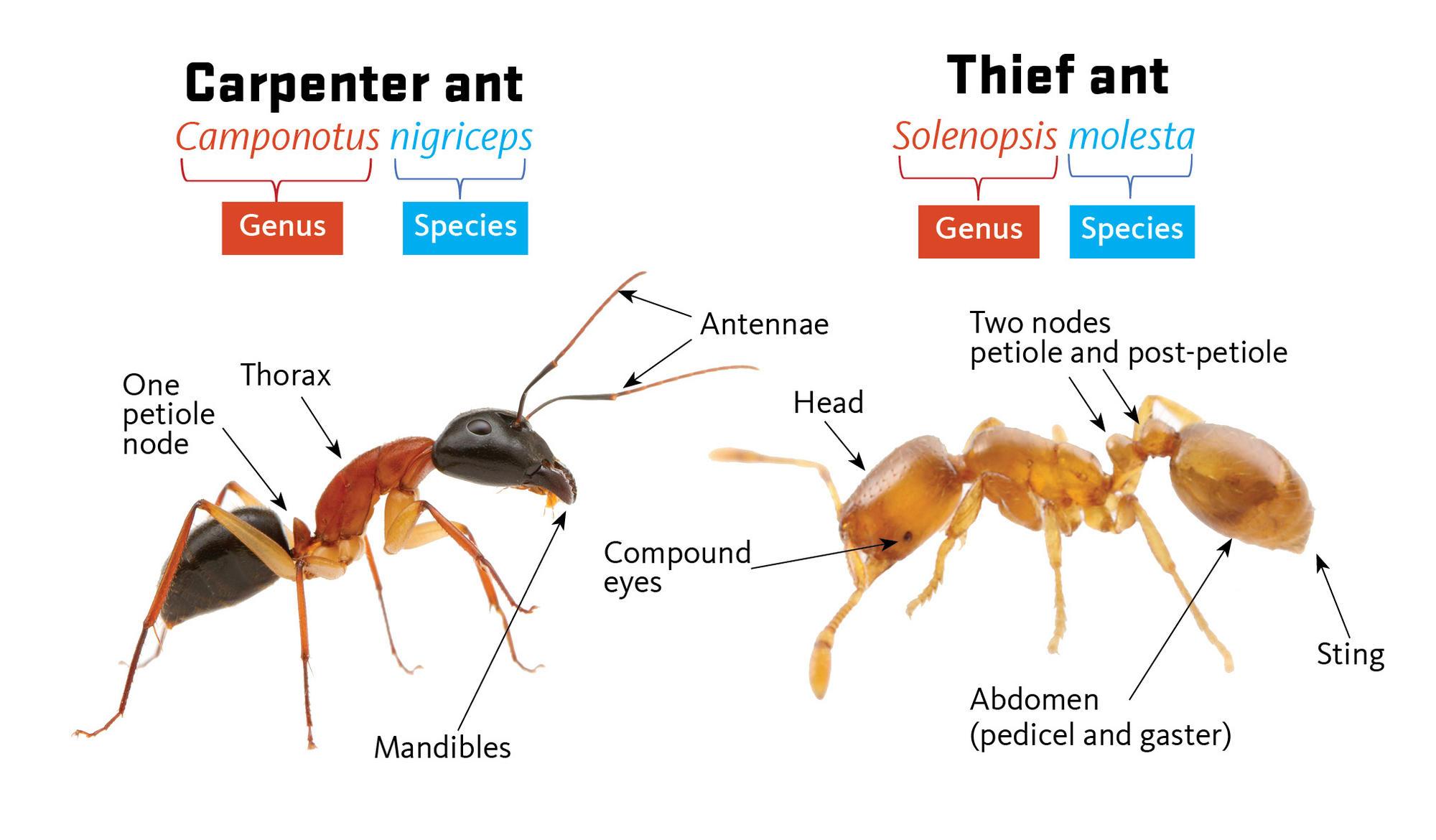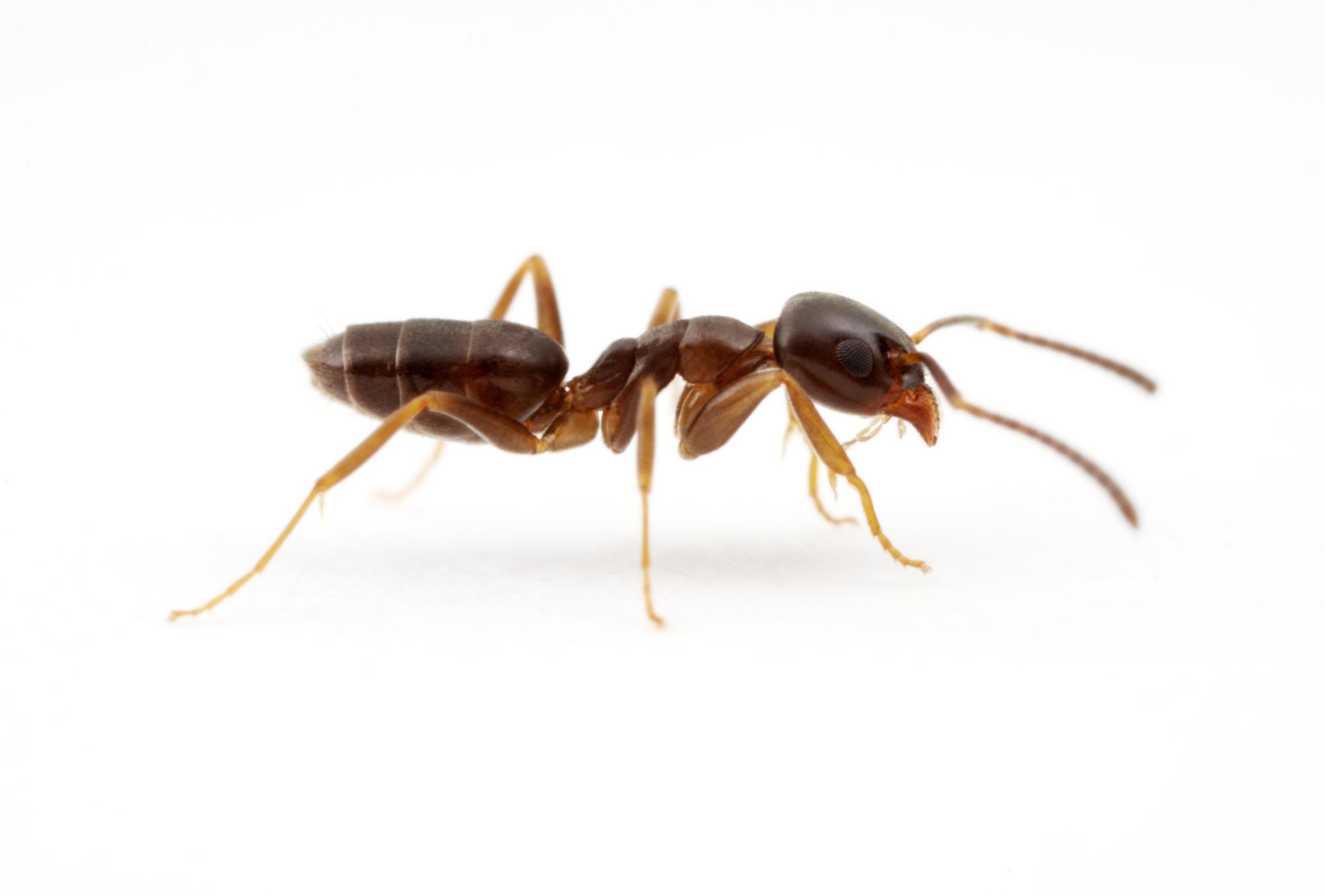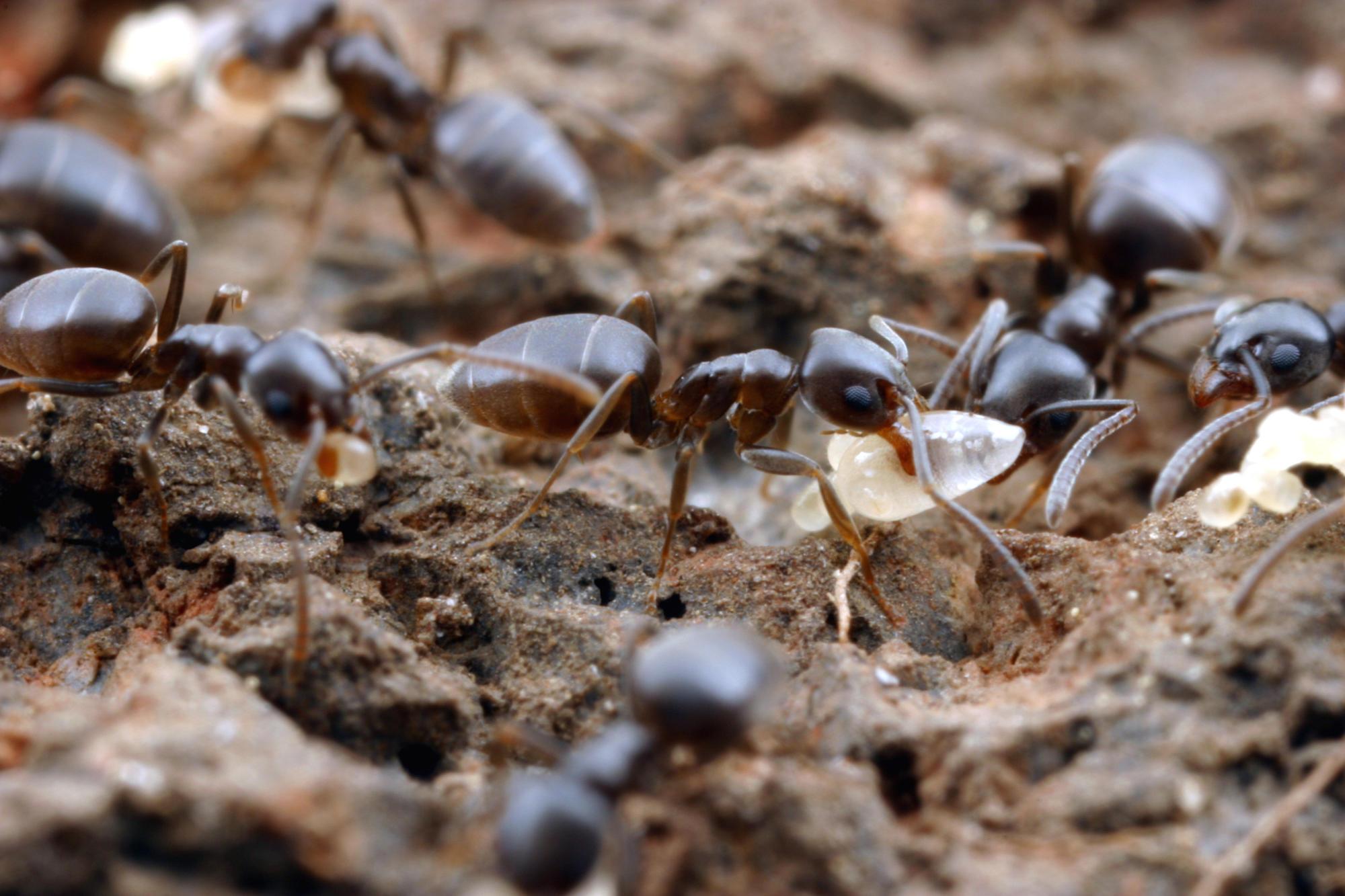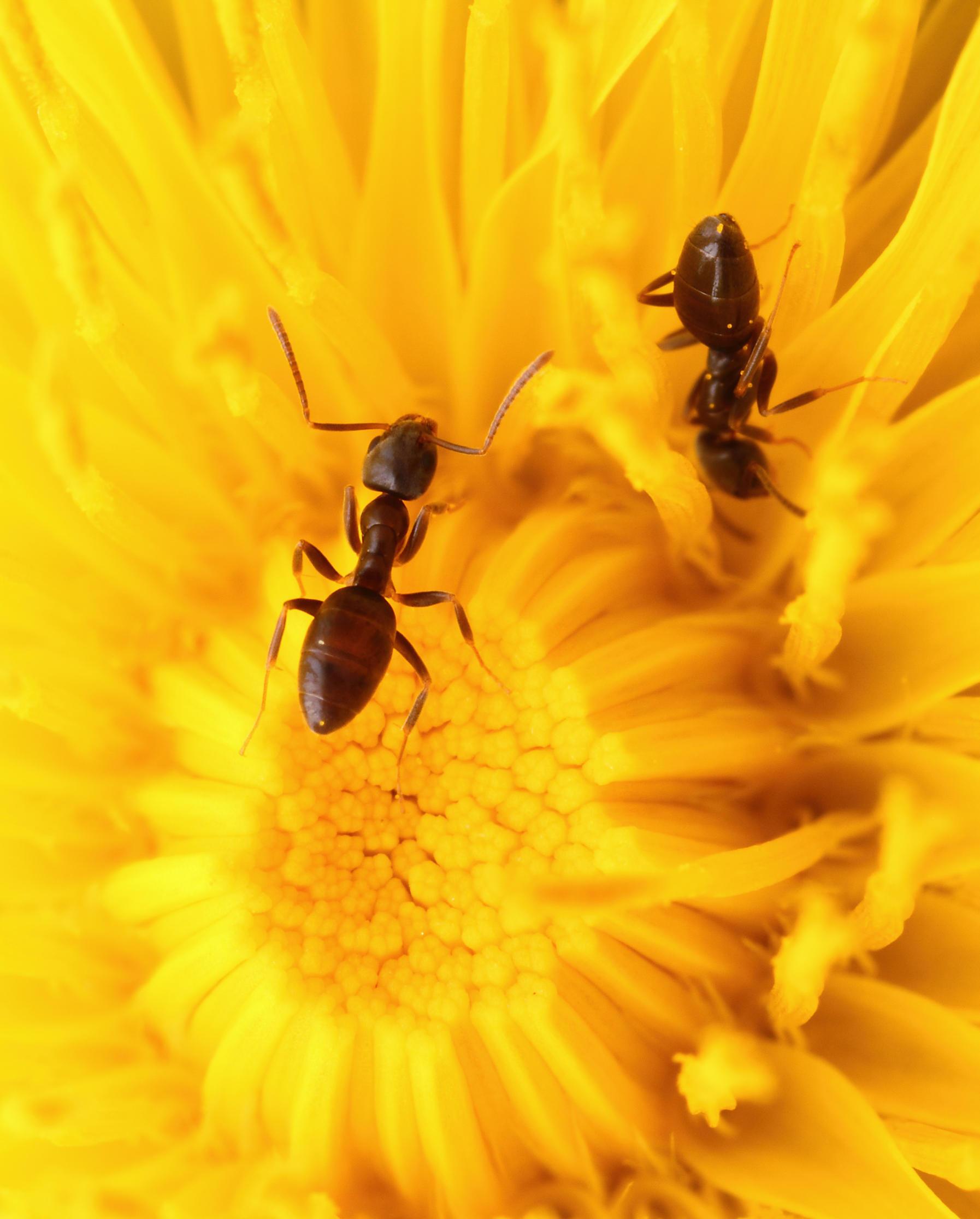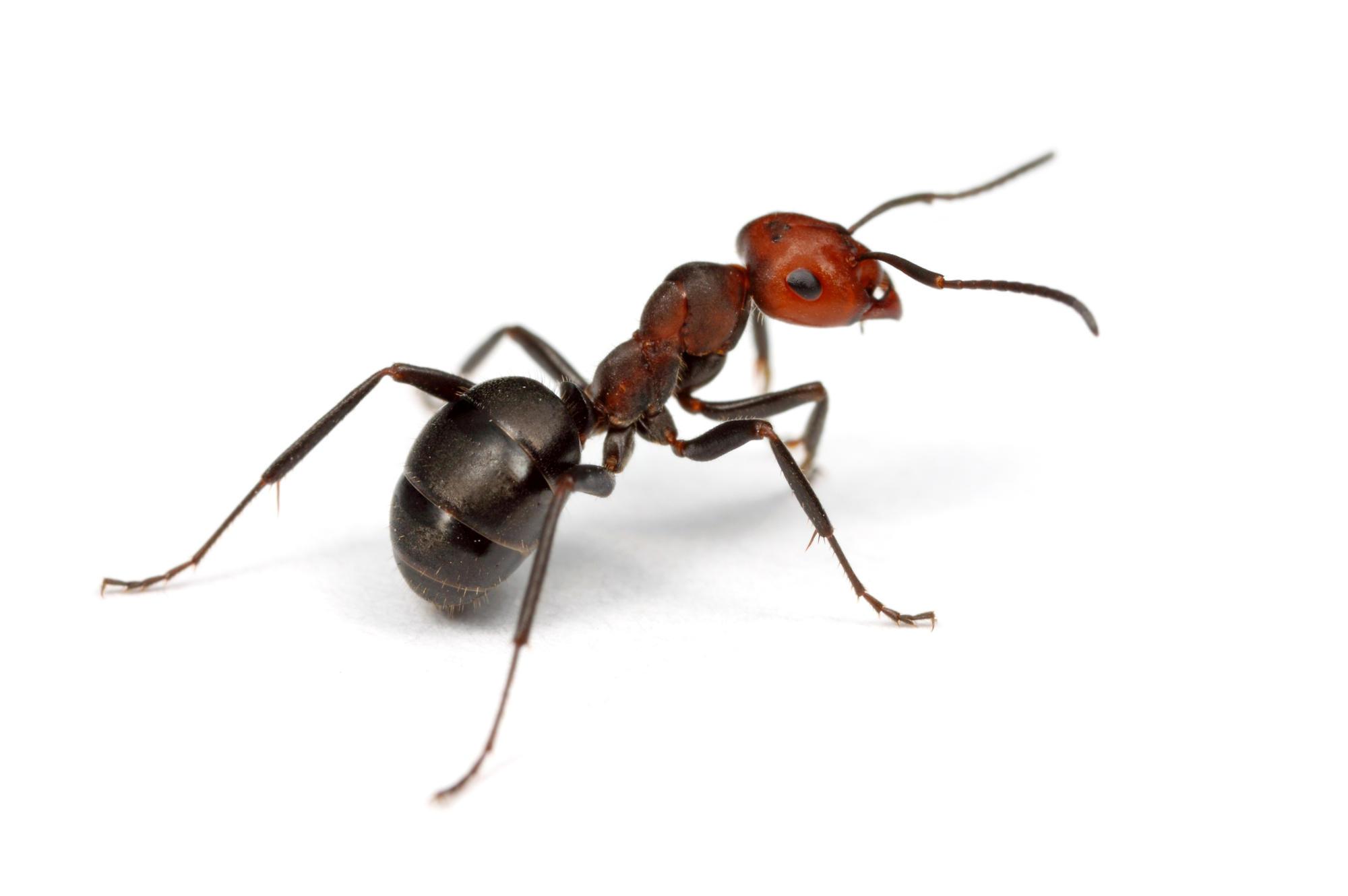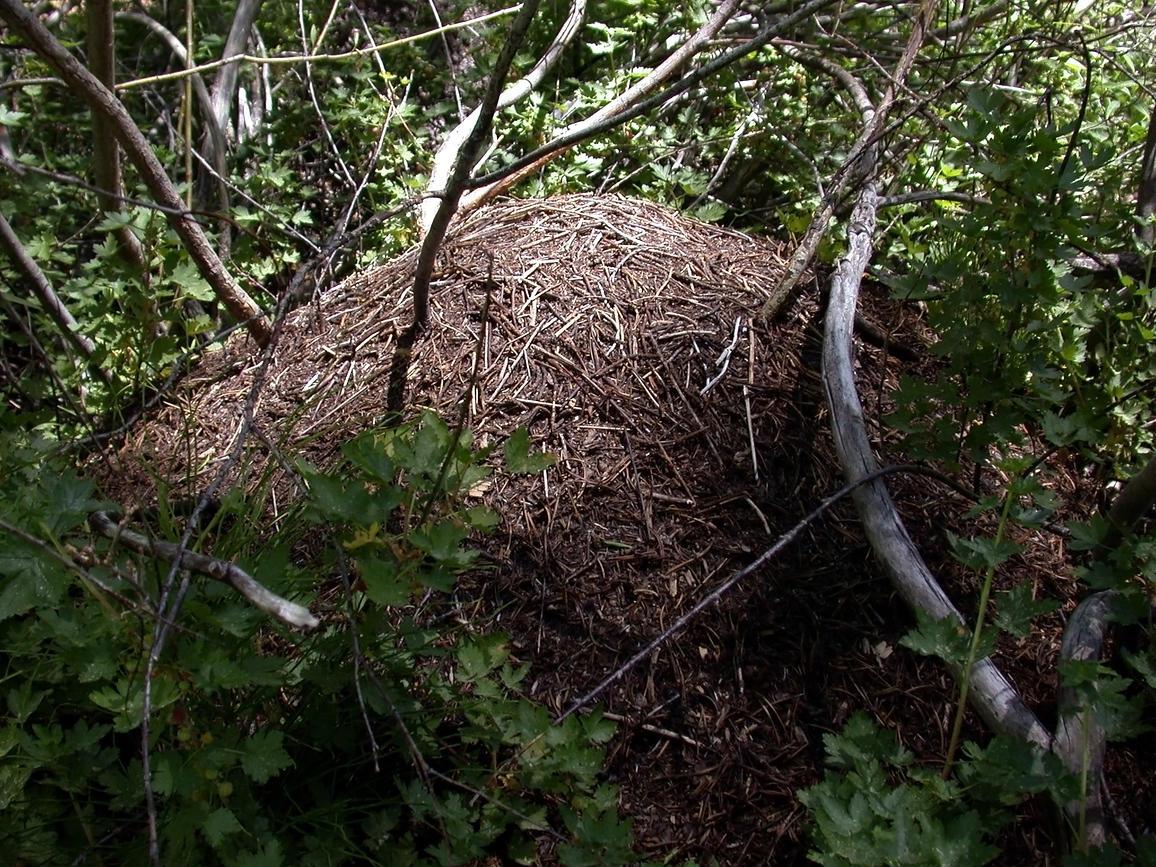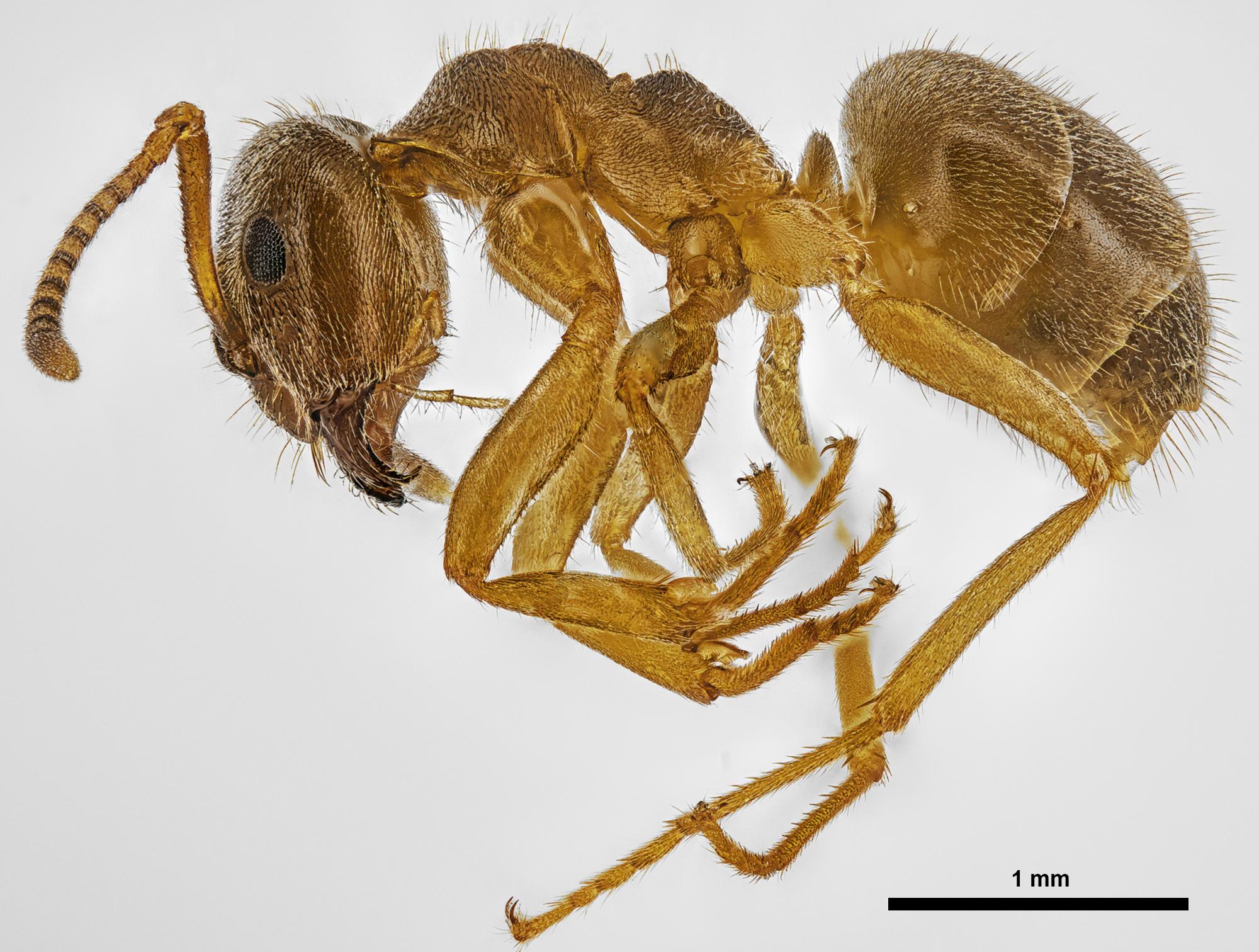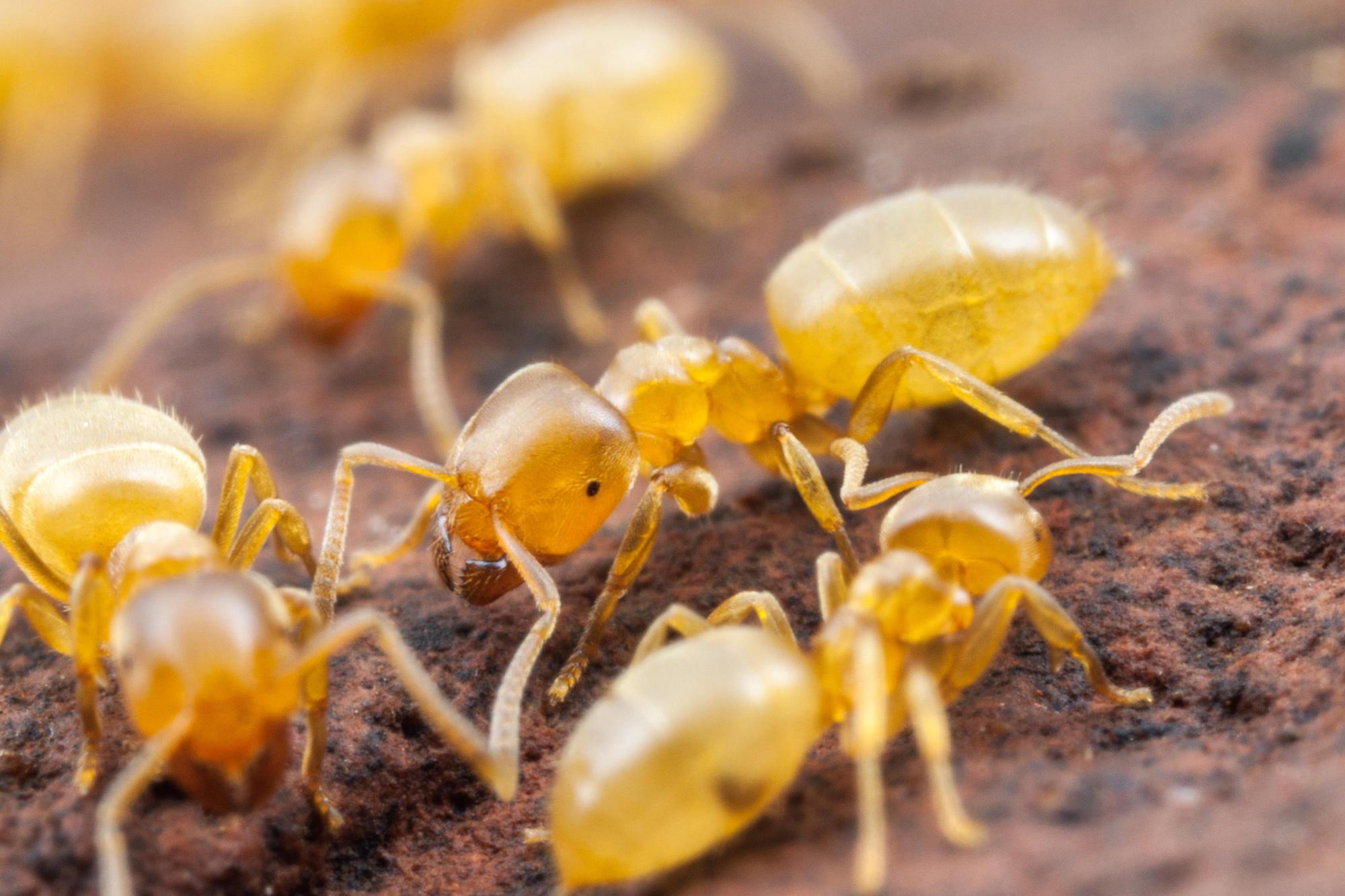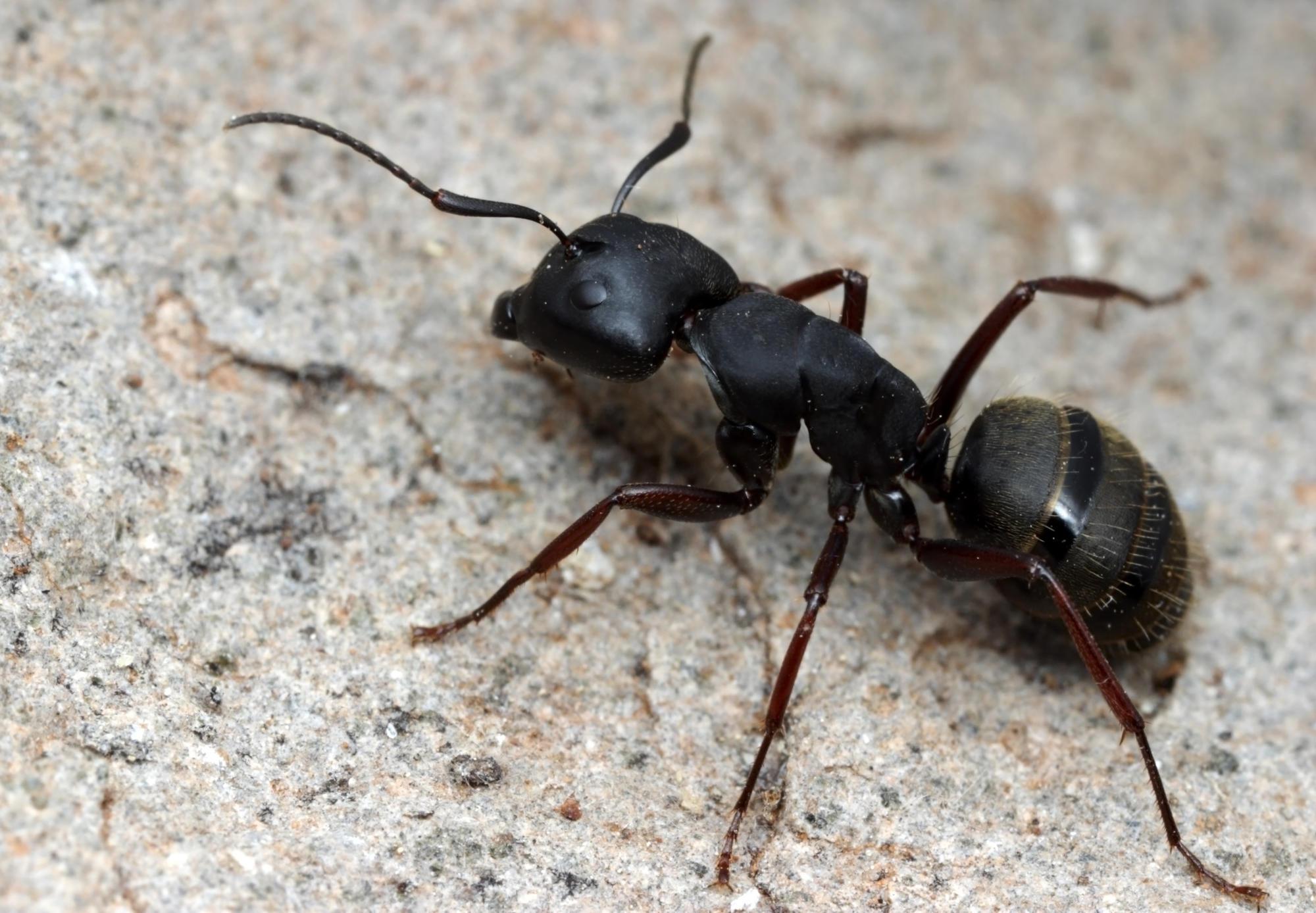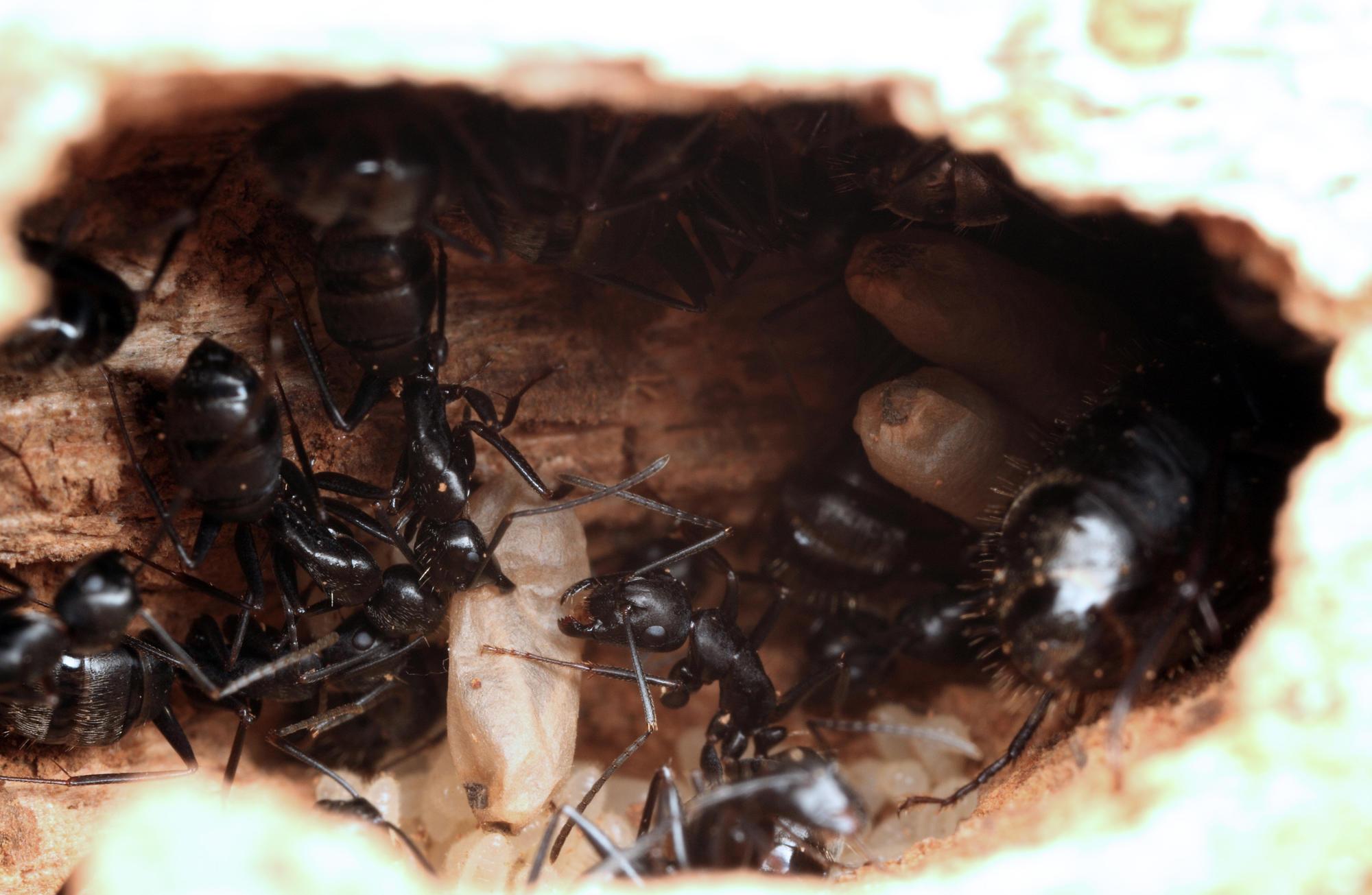Introduction
Ants invading school buildings is a common pest problem in the Pacific Northwest.
Ant species are often beneficial in landscape settings. They aerate the soil, distribute seeds and play an important role in recycling organic matter. Thus, outdoor ants may not need to be controlled.
But the same ant species obtain pest status when found indoors. When finding ants in school buildings, it’s critical that you identify the ants correctly before implementing any control or management tactic. The life histories of species differ significantly, and what may be a sound control action for one may make the situation worse for another.
Ants can be difficult to identify due to their small size and the vast number of species. But with some practice and a few basic tools, many people can determine which genus (Figure 1) of ant they have found. This is often enough to determine how to best manage a problem.
To identify ants, use a stereo dissecting microscope and illuminator or a 10x magnification loop with plenty of natural or artificial light. A clip-on magnifier lens for smartphones allows small ant parts, such as antennal segments, to be enlarged and counted. Images can also be submitted to your county Extension office for help with identification. You also need identification keys and a basic understanding of ant anatomy (Figure 1). For more information and identification keys, see Identification and Habits of Key Ant Pests in the Pacific Northwest (PNW 624) in the Resource section.
The rest of this publication will provide information on common ants and will cover:
- Why some species can be pests.
- The identification characteristics of common species.
- Basic biology and ecology.
- How to prevent, monitor and control pest ants.
Odorous house ant
Tapinoma sessile
Odorous house ants are found in all 48 contiguous American states and Hawaii. They thrive in a wide range of ecosystems with differing environmental conditions. You can find them around buildings, as well as in forests, riparian areas near watercourses and water bodies, grasslands, pastures and sandy coastal areas.
Odorous house ants become pests because they:
- Nest inside buildings when they discover food and water resources.
- Are omnivorous and will contaminate food they have access to.
- Search for resources and establish trails using pheromones produced in abdominal sternal glands.
- Tend and protect outdoor aphid, scale and mealybug populations from predators and parasites, sometimes causing indirect plant damage.
Odorous house ants do not sting and are ineffective biters.
Identification
Odorous house ants are also called sugar, stink and coconut ants.
Worker ants are all 2.5 mm to 3.5 mm in length and are uniform brown to black (Figure 2).
When disturbed, foraging workers run around erratically and release alarm pheromones from their abdomens.
Viewed from the top or the side, the ants do not have an obvious petiole (node). The single petiole is flat and hidden against the abdomen, also known as the gaster. The ants have 12-segmented antennae, and the thorax is uneven in shape when viewed from the side (Figure 2). Both these characteristics can only be viewed with magnification.
Experts distinguish odorous house ants from other small ants by crushing them in their fingers and then smelling them. The ants can smell like coconut, blue cheese, rancid butter or pine cleaning solution. However, there are several common ant species with a similar smell, so unless you are an experienced ant sniffer, odor may not be a reliable indicator.
Biology and ecology
Odorous house ants are hard to control because of their adaptability.
A colony can establish multiple subcolonies through a process called budding. When populations become too large, a queen and group of workers will carry some of the brood (juvenile ants) out of the original nest to a new location (Figure 3). Budding may also occur if a colony is disturbed by natural or human activities. Ants will also move subcolonies closer to food resources. Each subcolony may generate multiple egg-laying queens that form nonaggressive supercolonies. Related colonies are often connected by trails and redistribute food, workers and brood cooperatively. They are, however, aggressive to nonrelated odorous house ants and other species of ants in urban environments.
Supercolonies close to human habitation may contain tens or even hundreds of thousands of workers, but colonies living in natural habitats are relatively small and usually have a single queen. In outdoor environments, odorous house ants are active between April and October, with winged adults swarming in June or July. Indoor colonies remain active all year.
Outside, odorous house ants construct shallow ground nests under leaf litter, plants and stones and above-ground nests in tree hollows and stumps. They prefer shady, humid areas close to food resources. The ants forage on dead or living insects, take nectar meals from flowering plants, and honeydew from plant-feeding insects like aphids, scales and mealybugs (Figure 4).
When nesting indoors, odorous house ants occupy wall and floor voids or crawl spaces near warm, moist areas close to food and water resources. Indoors or outdoors, they will forage on sugary drinks, food spills, meats, fish, high carbohydrate foods and dairy products.
Monitoring, prevention and control
Odorous house ants use natural or human-made edges and ridges as they move around landscapes or structures. Sticky monitoring traps rarely intercept trailing ants. In school buildings, people notice them when ants trail (Figure 5) or cover an edible item (Figure 6) or moisture source (Figure 7).
When you notice ants, immediately remove any food or water resources attracting them. Vacuuming ants and mopping floor areas with a mild cleaning solution will disrupt pheromone trails, but ants rebuild the trail if access to food and water is not denied.
To resolve the problem, find interior nests or access points from outdoors. Follow ants traveling away from a food resource and seal any access points you discover. Odorous house ants forage at any time up to 150 feet from the nest, so ant appearances are intermittent and unpredictable. If you place index cards with a honey dollop where they have been reported, the ants will often trail to and from the honey within an hour. Trailing ants can then be followed to the nest location. If trails disappear under baseboards or into wall voids, inspect the outdoor area on the opposite side of the wall. If no ants are apparent, they may be nesting inside the wall or trailing a distance within the wall void. Once the nest is located, avoid disturbing the nest; that can prompt the colony to move.
Ultimately, nesting sites may require remediation using pesticide bait products. External nests may be treated with nonrepellent products, which are sweet liquid, gel, or granular baits (Figure 8). Additionally, there are gel and ready-to-use ant bait stations labeled for indoor use which can be deployed close to trailing ants or interior nests.
Foraging ants store food in a section of their gut called a crop, which is situated before the stomach in the ant’s abdomen. Ants fill their crop, then return to the nest to feed nonforaging ants. They regurgitate liquid food to transfer it to other colony members in a process called trophallaxis. (Figure 9). This is why slow-acting pesticide baits can reduce or eliminate a colony.
Discourage ants indoors and in landscapes by:
- Repairing indoor plumbing leaks.
- Keeping food in airtight containers or refrigerated.
- Cleaning and degreasing food-preparation surfaces, microwave ovens, refrigerators and kitchen appliances.
- Regularly emptying and cleaning trash cans and recycling bins.
- Cleaning mops, brushes, buckets and dustpans and storing them in a way that facilitates rapid drying.
- Ensuring that windowsills and doorways close snugly.
- Eliminating standing water around structures.
- Trimming trees and shrubs away from buildings so there is at least a foot of perimeter space between plants and building walls or roof lines.
- Sealing cracks around the building foundation.
- Keeping wood piles and lumber away from buildings.
- Avoiding wood and organic mulch close to buildings.
- Avoiding planting nectar-producing plants close to buildings.
Pavement ant
Tetramorium caespitum complex and Tetramorium immigrants
Pavement ants are commonly found in urban areas in the northeastern U.S., the Midwest and the Pacific Northwest. However, they have spread to most eastern and southern states. Pavement ants are closely associated with buildings and are adaptable to changes in urban landscaping.
Some species host parasitic ant species and provide overwintering sites for lycaenid butterflies within their colonies.
Tetramorium caespitum can destroy established colonies of red imported fire ant, Solenopsis invicta.
Pavement ants become pests because they:
- Can sting, although they rarely do.
- Form large colonies excavating large amounts of soil from under roads, walkways (Figure 10) and shallow building foundations, occasionally causing structural damage.
- Enter buildings and contaminate food they have access to.
- Form colonies inside structures.
- Damage vegetables in vegetable gardens.
- Can be an intermediate host of poultry tapeworms.
Identification
Worker ants are all 2.5 mm to 3 mm in length and are uniformly dark brown in color (Figure 11). Viewed from the top or the side, the ants have two nodes (Figure 11) and 12-segmented antennae with a three-segmented club (Figure 12). The head and thorax have longitudinal ridges (rugae) that run parallel from front to back, and the thorax is uneven in shape when viewed from the side (Figures 12, 13 and 14).
Pavement ants have propodeal spines (Figures 13 and 14), and the length of these differ between species. They also have anteroventral tooth structures (Figure 14) that distinguish them from other genera. All these distinguishing characteristics can only be viewed with magnification.
Biology and ecology
Colonies of Tetramorium caespitum usually have a single queen, but multiple queens are sometimes found in colonies. Large colonies with more than 10,000 workers are common. Winged ants searching for a mate swarm in early summer. When ants form colonies in warm buildings, swarming can happen inside structures at any time of the year.
Although pavement ants tolerate multiple ant and non-ant species (aphids, springtails, silverfish and mites) in their nests, they can be aggressive to nonrelated ants and engage in extensive battles (Figure 15).
Pavement ants scavenge on a wide variety of foods but favor sugary items. They also eat dead insects and take honeydew meals from plant-feeding insects. Some species will store seeds and grains for later consumption.
Workers recruit nestmates after finding food sources by deploying pheromones. Tetramorium caespitum workers will deposit a pheromone trail by wiping their gaster on surfaces they are walking on. Large groups of workers respond rapidly and quickly move food items back to the colony. Direct homing has also been documented in workers of Tetramorium caespitum. This is where workers do not follow foraging trails back to the nest but use visual cues to travel a direct path back to their colony.
Pavement ants can be particularly troublesome after heavy rain when subterranean colonies are flooded.
Monitoring, prevention and control
Pavement ants are managed using the same tactics and tools as odorous house ants.
Western thatching ant
Formica obscuripes
The western thatching ant is common in many parts of the western U.S., extending south throughout Arizona and New Mexico and east to Michigan and Missouri. Thatching ants are also referred to as “mound ants” or “wood ants.” They are generally considered to be beneficial or benign.
Western thatching ants become pests because:
- They injure plants and even young trees near their nests.
- They damage fruit tree buds, preventing fruit development.
- Their mounds mar manicured landscapes.
- Ants wander around indoors when their nests are near foundations or in wall voids.
- They bite and spray formic acid if humans or animals come in contact with them. Bites can cause discomfort and skin blistering. Wash sprayed skin areas immediately.
Identification
Workers are 4 mm to 9 mm in length. They have a red-orange head, darker orange or black thorax and a black abdomen. Legs and antennae can be red-orange or black (Figure 16). Viewed from the side, the ants have one node and a dip in the middle of the thorax (Figure 16). The last two characteristics can be better viewed with magnification.
Biology and ecology
Western thatching ants thrive in a wide variety of environmental habitats, including semiarid regions, prairies, deciduous forests, coniferous forests, sand dunes and alpine meadows. Their colonies typically have 10,000–40,000 workers, although some have hundreds of thousands. Workers forage during the day and perform nest maintenance on their mounds. Single colonies have multiple nesting sites, with secondary nests often constructed at the base of plants where the workers collect honeydew from plant-feeding aphids, scales and mealybugs. Colonies have multiple queens, and winged adults swarm in late summer. Colonies also multiply by budding.
Formica obscuripes build large nests (Figure 17) using soil and vegetative matter, including woody twigs and stems. Colonies host several kinds of beetles, springtails, true bugs, flies and other ant species.
Western thatching ants are omnivores preying on insects and other arthropods and feasting on honeydew (Figure 18). In the Pacific Northwest, they are active between April and October and overwinter in the nest.
Monitoring, prevention and control
Western thatching ants are managed using similar tactics and tools as odorous house and pavement ants. However, they rarely establish trails indoors. Avoid putting mulch next to external walls or piling rotting wood on school property. Like odorous house and pavement ants, the western thatching ant will consume sweet ant baits.
Large mounds within playgrounds are difficult to immediately remediate. Experienced IPM staff or pest management professionals may need to treat mounds directly. Wear personal protective equipment to protect against ant bites and formic acid injury.
Velvety tree ants
Liometopum occidentale and Liometopum luctuosum
The velvety tree ant (Liometopum occidentale) is common in many parts of the western U.S. extending south into Mexico. Another species, Liometopum luctuosum, is more commonly known as the pine tree ant, and occurs at higher elevations above 2,000 meters (6,500 feet).
Velvety tree ants are often misidentified as carpenter and odorous house ants. When crushed, they smell like coconut. Liometopum species have an erect node on the waist while odorous house ants have a flat node. Carpenter ants have a circular opening at the end of the gaster surrounded by hairs, and velvety tree ants have a slit-shaped opening without hairs.
Velvety tree ants become pests because:
- Liometopum occidentale and L. luctuosum will damage insulation and tunnel into structural wood.
- They construct temporary nests within wall voids.
- When threatened, velvety tree ants bite and produce a noxious alarm pheromone containing acetic, butyric and isovaleric acids.
Identification
Workers differ in appearance and size. Liometopum occidentale are 2.5 mm to 5.5 mm in length, and bicolored with a brown head and abdomen and lighter brown or reddish-brown thorax (Figures 19 and 20). L. luctuosum are 2.5 mm to 4.5 mm in length, and uniformly brownish black in color (Figure 21). Viewed from the side, the ants have one node and a smooth convex thorax. Their body is covered with hair. This is not easily seen without magnification.
Biology and ecology
Velvety tree ants build shallow nests in forested areas. They nest in or under fallen timber or around homes under cut logs and lumber. They are the dominant ant in oak and pine forests of the southwestern U.S. They are also common in western urban areas. The ants build paper-like nests referred to as “carton” by pest management professionals. The carton nests are formed from chewed-up wood and soil particles held together by secretions from glands in the ants’ mouths. The nests may be difficult or impossible to locate. Like carpenter ants, velvety tree ants chew wood but do not eat it.
Carpenter ants and velvety tree ants both produce frass, but velvety tree ant frass is finer. Still, you’ll be better able to identify ants using a microscope or magnification.
Velvety tree ants have multiple nest sites, and colony sizes for both species range from 40,000 to 60,000 workers. Colonies have multiple queens, and winged adults swarm in summer.
Foraging ants generate trails up to 185 meters (600 feet) in length. Workers travel in shallow galleries or through ground vegetation. They forage in high numbers both day and night during the spring and early summer, but when daytime temperatures exceed 95oF (35oC) the ants restrict foraging to nighttime.
Velvety tree ants are omnivores and take honeydew meals from plant-feeding aphids, scales and mealybugs.
Monitoring, prevention and control
Velvety tree ants will construct temporary nests within wall voids, so follow foraging trails to locate their outside colonies. Avoid storing logs or lumber near buildings. Use sweet liquid pesticide baits and place bait stations near primary nests, satellite nests and foraging trails. Since workers forage so far from the nest, controlling these ants is difficult. The primary nests may not be on school grounds.
Moisture ants
Lasius pallitarsis
There are at least nine species of moisture ants in the Pacific Northwest, but the pale-legged field ant Lasius pallitarsis is the most common. These species are hard to distinguish from one another, so we’ll discuss the entire genus Lasius moisture ants in this section.
Moisture ants are widespread in the U.S. They are also known as garden or cornfield ants.
They become pests because they invade buildings and nest in structural voids close to high humidity and warmth.
Identification
Workers are 3 mm to 4 mm in length, and the different species range from uniformly pale cream to brown or black. Viewed from the side, the ants have one node and an uneven thorax (Figure 22). They have 12 segmented antennae, a circular epinotal spiracle (opening) covered with hair (Figure 22). Distinguishing features cannot be seen without magnification. Some species smell a little like citronella when crushed.
Biology and ecology
Moisture ants nest in rotting logs and tree stumps in the forest. Around homes, they nest in similar locations and under stones in moist, shaded areas. If nests are close to buildings, they may forage indoors. They do not eat wood and are not considered a structurally damaging pest. But they tunnel through rotting wood, and their presence can indicate structural decay.
They have multiple queens, and colony size averages 4,000 to 7,000. Some colonies can establish numbers in the tens of thousands. Winged ants swarm during the late summer and autumn.
Moisture ants are versatile feeders, foraging most often after dark. They favor sweet foods and will take honeydew meals from plant-feeding aphids, scales and mealybugs.
Monitoring, prevention and control
Moisture ants are managed using the same tactics and tools as odorous house and pavement ants.
Carpenter ants
Camponotus modoc
There are at least 10 species of carpenter ants in the Pacific Northwest, but Camponotus modoc is the most common (Figure 25). The Camponotus species are variable, and covering relevant aspects of their biology, ecology and management is beyond the scope of this publication. However, the information below will provide identification information useful in differentiating carpenter ants from the ants covered in this publication.
Carpenter ants become pests because they damage insulation and structural wood by tunneling into beams and hollowing out areas for nesting (Figure 26). Carpenter ants do not eat the wood but generate sawdust on the floor or ground under ant tunnel entry points.
Carpenter ants generally have a primary nest outside but sometimes build satellite nests in wall voids and other structural voids.
Identification
Workers vary in size and color depending on the species. Some species have minor and major workers that differ in size and appearance. Camponotus modoc are matte black with dark red legs. Workers range from 6 mm to 13 mm. Viewed from the side, the ants have one node, and a smooth rounded thorax. A key distinguishing feature is a circle of hairs at the tip of the abdomen. This is not easily seen without magnification.
For additional information regarding carpenter ants in schools see: IPM Action Plan for Carpenter Ants.
Special considerations for schools
Ants are abundant in healthy outdoor environments and play important roles in both natural and school landscapes. Their tunneling through soil and redistribution of organic matter helps aerate soil, which promotes drainage and reduces compaction. Ants are major players in seed dispersal and organic matter recycling and can be wonderful instructional aids for teachers.
Some ants sting, some do not
Ants are close relatives of bees and wasps in the insect order Hymenoptera. Thus, some species sting defensively when threatened. Others can cause injury by biting and spraying acid over bite wounds.
Neither the red imported fire ant (Solenopsis invicta) nor the black imported fire ant (Solenopsis richteri ) or their hybrid are established in the Pacific Northwest. However, the European fire ant and the Asian needle ant (Brachyponera chinensis) have been reported in Washington state and could become widespread. Both species are associated with cases of human anaphylaxis.
European fire ants favor high humidity and moist soil. They construct nests at the base of trees and shrubs, under rocks and in moist, shady timber areas. The colonies have multiple queens and establish satellite colonies through budding. The workers can be aggressive and inflict a painful sting, which can cause allergic reactions in sensitive individuals.
Asian needle ants favor dark, damp habitats in urban environments and disturbed rural environments. They prey on subterranean termites, and colonies have multiple nest sites and multiple queens. Workers and winged females can inflict a painful sting.
Reactions to ant stings can be serious. If you are concerned about ant populations on your school campus, contact your pest management professional or local Extension office and request identification assistance.
Management reminders
- 90% of ant management is focused on ant exclusion (pest-proofing the building), good sanitation, good waste management practices and habitat management around school buildings.
- Report indoor ants to your IPM coordinator or facilities manager as soon as possible.
- Vacuum up trailing ants, remove and seal the vacuum bag in a plastic bag, and place in an outside dumpster.
- Scrub or mop with soapy water to remove pheromone trails.
- Use slow-acting baits, if needed. Baits should be used outdoors and not be accessible to students.
- If stinging ants are a concern, the affected campus location may be cordoned off temporarily using caution tape.
Resources
References
- Buczkowski, G. 2010. Extreme life history plasticity and the evolution of invasive characteristics in a native ant. Biological Invasions, 12/9;3343-3349.
- King, T.G., S.A. Phillips Jr. 1992. Destruction of young colonies of the red imported fire ant by the pavement ant (Hymenoptera: Formicidae). Entomological News 103;72-77.
- Shen, J.X., Z.M. Xu, E. Hankes. 1998. Direct homing behaviour in the ant Tetramorium caespitum (Formicidae, Myrmicinae). Animal Behaviour 55;1443-1450.

